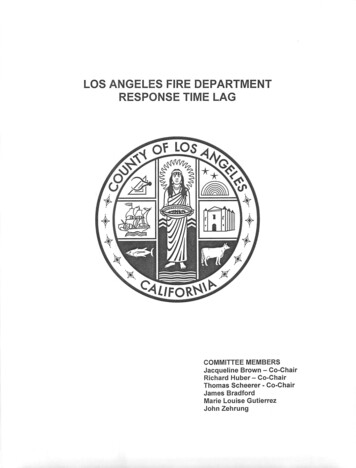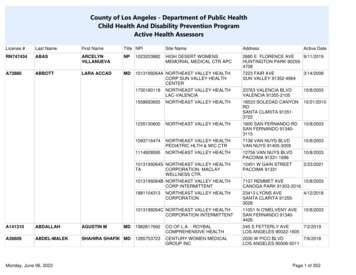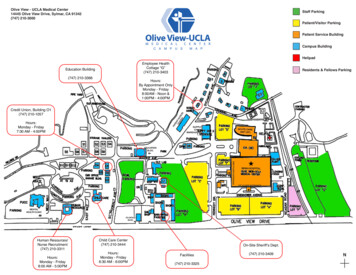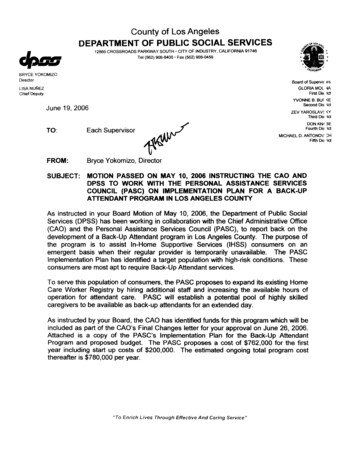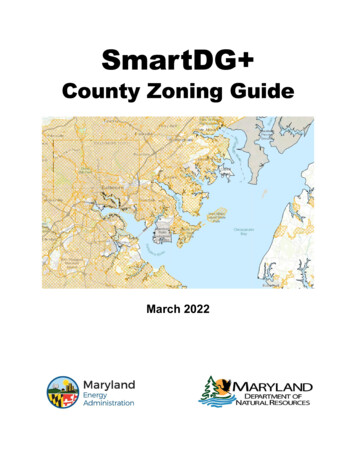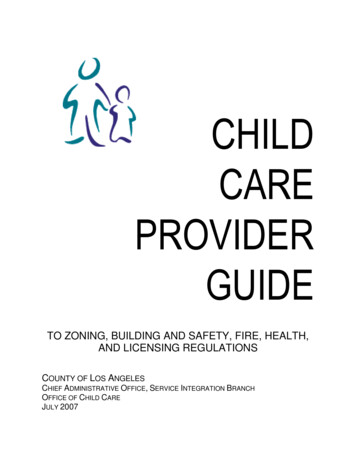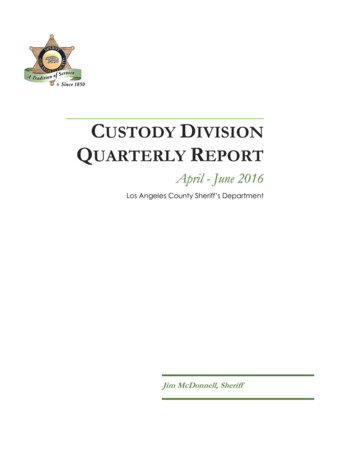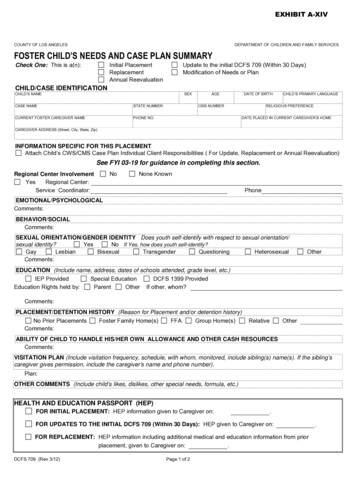
Transcription
EXHIBIT A-XIVCOUNTY OF LOS ANGELESDEPARTMENT OF CHILDREN AND FAMILY SERVICESFOSTER CHILD’S NEEDS AND CASE PLAN SUMMARYInitial PlacementReplacementAnnual ReevaluationCheck One: This is a(n):Update to the initial DCFS 709 (Within 30 Days)Modification of Needs or PlanCHILD/CASE IDENTIFICATIONCHILD’S NAMESEXCASE NAMESTATE NUMBERCURRENT FOSTER CAREGIVER NAMEPHONE NO.AGEDATE OF BIRTHCSIS NUMBERCHILD’S PRIMARY LANGUAGERELIGIOUS PREFERENCEDATE PLACED IN CURRENT CAREGIVER’S HOMECAREGIVER ADDRESS (Street, City, State, Zip)INFORMATION SPECIFIC FOR THIS PLACEMENTAttach Child’s CWS/CMS Case Plan Individual Client Responsibilities ( For Update, Replacement or Annual Reevaluation)See FYI 03-19 for guidance in completing this section.Regional Center InvolvementYesRegional Center:Service Coordinator:NoNone /SOCIALComments:SEXUAL ORIENTATION/GENDER IDENTITY Does youth self-identify with respect to sexual orientation/sexual identity?YesNo If Yes, how does youth ningHeterosexualComments:OtherEDUCATION (Include name, address, dates of schools attended, grade level, etc.)IEP ProvidedSpecial EducationDCFS 1399 ProvidedParentOther If other, whom?Education Rights held by:Comments:PLACEMENT/DETENTION HISTORY (Reason for Placement and/or detention history)No Prior PlacementsFoster Family Home(s)FFAGroup Home(s)Comments:RelativeOtherABILITY OF CHILD TO HANDLE HIS/HER OWN ALLOWANCE AND OTHER CASH RESOURCESComments:VISITATION PLAN (Include visitation frequency, schedule, with whom, monitored, include sibling(s) name(s). If the sibling’scaregiver gives permission, include the caregiver’s name and phone number).Plan:OTHER COMMENTS (Include child’s likes, dislikes, other special needs, formula, etc.)HEALTH AND EDUCATION PASSPORT (HEP)FOR INITIAL PLACEMENT: HEP information given to Caregiver on:.FOR UPDATES TO THE INITIAL DCFS 709 (Within 30 Days): HEP given to Caregiver on:FOR REPLACEMENT: HEP information including additional medical and education information from priorplacement, given to Caregiver on:.DCFS 709 (Rev 3/12)Page 1 of 2.
EXHIBIT A-XIVCOUNTY OF LOS ANGELESDEPARTMENT OF CHILDREN AND FAMILY SERVICESFOSTER CHILD’S NEEDS AND CASE PLAN SUMMARYInitial PlacementReplacementAnnual ReevaluationCheck One: This is a(n):Update to the initial DCFS 709 (Within 30 Days)Modification of Needs or PlanCHILD/CASE IDENTIFICATIONCHILD’S NAMESEXCASE NAMESTATE NUMBERCURRENT FOSTER CAREGIVER NAMEPHONE NO.AGEDATE OF BIRTHCSIS NUMBERCHILD’S PRIMARY LANGUAGERELIGIOUS PREFERENCEDATE PLACED IN CURRENT CAREGIVER’S HOMECAREGIVER ADDRESS (Street, City, State, Zip)INFORMATION SPECIFIC FOR THIS PLACEMENTAttach Child’s CWS/CMS Case Plan Individual Client Responsibilities ( For Update, Replacement or Annual Reevaluation)See FYI 03-19 for guidance in completing this section.Regional Center InvolvementYesRegional Center:Service Coordinator:NoNone /SOCIALComments:SEXUAL ORIENTATION/GENDER IDENTITY Does youth self-identify with respect to sexual orientation/sexual identity?YesNo If Yes, how does youth ningHeterosexualComments:OtherEDUCATION (Include name, address, dates of schools attended, grade level, etc.)IEP ProvidedSpecial EducationDCFS 1399 ProvidedParentOther If other, whom?Education Rights held by:Comments:PLACEMENT/DETENTION HISTORY (Reason for Placement and/or detention history)No Prior PlacementsFoster Family Home(s)FFAGroup Home(s)Comments:RelativeOtherABILITY OF CHILD TO HANDLE HIS/HER OWN ALLOWANCE AND OTHER CASH RESOURCESComments:VISITATION PLAN (Include visitation frequency, schedule, with whom, monitored, include sibling(s) name(s). If the sibling’scaregiver gives permission, include the caregiver’s name and phone number).Plan:OTHER COMMENTS (Include child’s likes, dislikes, other special needs, formula, etc.)HEALTH AND EDUCATION PASSPORT (HEP)FOR INITIAL PLACEMENT: HEP information given to Caregiver on:.FOR UPDATES TO THE INITIAL DCFS 709 (Within 30 Days): HEP given to Caregiver on:FOR REPLACEMENT: HEP information including additional medical and education information from priorplacement, given to Caregiver on:.DCFS 709 (Rev 3/12)Page 1 of 2.
EXHIBIT A-XIVCOUNTY OF LOS ANGELESDEPARTMENT OF CHILDREN AND FAMILY SERVICESFOSTER CHILD’S NEEDS AND CASE PLAN SUMMARYThe attached Health and Education Passport contains the following information. Annotate the HEPas needed. Explain any missing information.Check if Information available on HEPA. HEALTH CARE PROVIDERSNameAddressPhoneDate last seenIf not available, explainChild’s Physician:Child’s Dentist:Other:B. ALLERGIES (List all known food, drug and other allergies and reaction)None KnownYes, explainYesNo, explainNone KnownYes, explainComments:C. IMMUNIZATIONSNoComments:D. MEDICAL/PSYCHOLOGICAL PROBLEMS (Significant past/present or chronic conditions)Comments:NoIndicate if the following information is currently available in the Health and Education Passport. Provide anexplanation for any missing information.Medication(s) Prescribed/Medical Date MedicationsDate DiagnosedPrimary Diagnosis(es) Contagious/ InfectiousEquipment/Tx PlanDiscontinuedYesNo(If no, explain)YesNoYesNoYesNoYesNoReviewed and Approved by SCSW:Print SCSW’s NameOffice AddressPhoneSCSW’S SignatureDateCaregiver reviewed, understands and agrees to support the child’s case plan as described above; has determined the child iscompatible with others in the home. Caregiver agrees to keep all of the child’s case information confidential and understandsthat unauthorized disclosure could result in a fine up to 1,000. Caregiver acknowledges receipt of the Health and EducationPassport with the above information included or an explanation of why the information is not included.Caregiver’s SignaturePrint CSW’s NameDateOffice AddressCSW’S SignatureDCFS 709 (Rev. 2/05)PhoneDatePage 2 of 2Copy to: CaregiverDCFS Case File (Placement Folder)
EXHIBIT A-XVLOS ANGELES COUNTY SUPERIOR COURTJUVENILE COURT VISITATION COMMITTEEEXHIBIT CCFAMILY VISITATIONGUIDELINESJUVENILE DEPENDENCY COURT PROTOCOLFOR DEVELOPING FAMILY VISITATION PLANS
EXHIBIT A-XVEXHIBIT CCTABLE OF CONTENTSINTRODUCTION/SUMMARY3PURPOSE/PHILOSOPHY STATEMENT4TEAMING PROCESS6COURT ORDERS8DEPENDENCY CASE STAGES9Stage 1: Pre-Detention Hearing Family Visitation Plan (Initial 72 Hours Following Removal)Stage 2: Detention Hearing/Pre-Disposition Family Visitation PlanStage 3: Disposition Family Visitation PlanFamily Visitation Plan ReviewPost-Jurisdiction Visitation Plans910111111FAMILY VISITATION PLAN12Preliminary Considerations/Factors to ConsiderParticipants 1 Considerations and ResponsibilitiesJudicial Officers' and Attorneys' Considerations and ResponsibilitiesFamily Visitation Plan Elements131318191919192020202121222222Visitation Objectives (reason for each visit)Frequency of VisitsDevelopmental Visitation GuidelinesAdditional Visitation ContactsPersons to Participate in VisitationVisitation for Teen Dependent Parents and Their ChildrenSibling VisitationType of SupervisionVisit LocationVisitation ProblemsVisiting in Specific ------Safety PlanningTeam AgreementChanges to the FVP - - - - - - - - - - - - - - - - - - - - - - - - - - - - - - -24242424BIBLIOGRAPHY 25SUB-COMMITTEE M E M B E R S - - - - - - - - - - - - - - - - - - - - - - - - 262
EXHIBIT A-XVEXHIBIT CCINTRODUCTION/SUMMARYIn June, 2005, the Los Angeles County Juvenile Dependency Court convened a committee to create visitationguidelines for the County of Los Angeles. The Court recognized the pivotal role that visitatio n plays in thereunification process, the importance of considering child development is sues in relation to visitation, and thelack of a cohesive system for creating effective and appropriate visitation plans.The Visitation Guidelines Committee reviewed numerous documents in preparing these protocols (seeattached bibliography). The Drafting Subcommittee consisted of community stakeholders from throughoutthe juvenile court system with expertise in policy, social work, and training, including a number ofrepresentatives from the Department of Children and Family Services (DCFS).The resulting protocols provide a cohesive system for creating family visitation plans (consistent with courtorders) designed and later re -asse ssed in team meetings that include all of the people affected by visitation.1These plans must be specific in nature (as to time, location, transportation arrangements, and activities),taking into consideration the purpose of the visits, the strengths and needs of the parents and children, therole of the supervisor (if any), alternatives to in-person visitation, and a myriad of other issues that areoutlined in detail in this do cum en t.At the time of detention, DCFS needs to evaluate what visitation/ contact is appropriate and create an initialplan for such visitation, preferably through a team process. At the initial detention hearing, the Court willusually make general visitation orders. A detailed family visitation plan, consistent with the more generalcourt orders, will need to be created by a Family-Centered Team involving as many participants asappropriate (including parents, relatives, caregivers 2 , children, and service providers). Whenever feasible, thisplan should be created prior to the disposition hearing, and a copy should be provided to the Court. As thecase progresses and placements change, the plan will be modified, including liberalization of visits, whenwarranted.These guidelines are adopted with the understanding that full implementation will require DCFS protocols tobe drafted that are consistent with this document, training will have to be developed, forms will have to becreated, and resources will need to be identified. Additional efforts of the Visitation Guidelines Committeewill focus on identifying resources to help facilitate visitation, and ensuring sufficient training of Children'sSocial Workers. While DCFS will be responsible for training social workers and caregivers, the Committeecurrently envisions the creation of a team to design cross-training of the other dependency systemstakeholders (e.g. attorneys, judicial officers, CASA staff and volunteers).111us team based approach was pro posed m the Family Reumfication Report, the p roduct of a work group convened by the LosAngeles Cou n ty Commission for Children and Families and DCFS m 2004.2 For the purposes of this document, the term "caregiver" includes relative caregiVers, foster parents, foster farruly agency staff, andgroup home staff3
EXHIBIT A-XVEXHIBIT CCPURPOSE/PHILOSOPHY STATEMENTThese guidelines provide specific tools, protocols, and strategies for ensuring that planned and purposefulvisitation occurs for children and families served by the Los Angeles County Child Welfare System.Supported by research, best practice standards and legal statutes, visitation serves as the most essential serviceelement for these families towards achieving the outcomes of safety, permanence and well-being. Morespecifically, visitation is the most critical factor in ensuring and supporting safe and timely re-unification forchildren and their birth families as the primary permanency option. Its central and fundamental place amidthe array of services and supports to at risk families cannot be understated.The success of visitation is contingent upon every involved party valuing the importance of the visitation'spurpose. This document provides guidance to (and sets standards for) those individuals and groups who playkey roles in supporting families and is based on the following principles / values and themes: The law (Welfare and Institutions Code ("WIC") sections 300 and 30 8) provides specific guidancefor developing, implementing and monitoring visitation plans and shall be the primary point ofreference in the development and implementation of visitation plans and protocols. While recognizing the statutory authority and mission of the Juvenile Court and DCFS; communitystakeholders, partnering agencies and families share responsibility and accountability for outcomes.Con sis tent with emerging/ best practice, such outcomes are more readily achieved through "teambased" approaches to decision-making, assessment, planning and support. Therefore, team basedapproaches to developing and updating Fami(y Visitation Plans (FVPs) are strongly referenced in thisdocument. In delivering child welfare services, priority consideration should always be given to the delivery ofcommunity and family based interventions that allow children to safely remain with their families andin their communities. The provision of out-of-home care is always a last resort when these in-homeservices and interventions cannot adequately ensure child safety. When out-of-home care is needed, it must serve as a goal directed service to achieve safety andpermanency for children in environments where essential connections for children are maintained.Therefore, in the placement process, any and all effo rts shall be made to maximize and maintain achild's healthy connections with family, culture, community and school-of-origin . This includes theplacing of siblings together and supporting healthy sibling bonds, unless in so doing, child safety iscompromised. When out-of-home care is necessary, visitation should serve as a family-centered, family empoweringactivity to assess, maintain, strengthen and re-build healthy family and community connections whilereducing identified risks. It not only serves to maintain contact/ access between parents and children,but allows family members to practice and demonstrate new skills / behaviors that are needed forthem to safely be together. As such, visitation plans and activities should be inexorably linked to auniquely tailored Case Plan that clearly identifies outcomes for the family, builds on their strengthsand resources, and meets specific child and family needs. Across time, if re-unification is found notto be possible, visitation allows parents, children and caregivers to be more directly and activelyengaged in the concurrent planning process to support timely development and activation of analternative permanent plan. Visitation plans developed with and for family members (including parents, siblings and other4
EXHIBIT A-XVEXHIBIT CCrelatives) should reflect the unique child and family situation based on their place in the continuumof service delivery and juvenile court process. They should also include a wide range of contact andaccess formats from face-to-face visitation to any and all other forms of written, telephonic, email,and/ or video contact. Where appropriate, visitation should also include significant others who havea meaningful and supportive relationship with the child and family and who may also play a key rolein achieving case goals. These guidelines assume that a determination has been made that visitation is in the best interests ofeach child and will not negatively impact the child's physical and / or emotional well-being. Whenvisitation is appropriate, the visitation plan should be specifically tailored to the particular family andcare should be given at all times to protect the child from physical and/ or emotional harm.As Family Visitation Plan are implemented, it is the shared responsibility of those working with thefamily to monitor implementation, providing feedback and working together to address specific issuesand concern s regarding the quality, timeliness and quantity of visitation that occurs for a family.5
EXHIBIT A-XVEXHIBIT CCTEAMING PROCESSFamily-Centered Team-Decision Making ("FTDM") is a collaborative concept in which the Department ofChildren and Family Services ("DCFS") staff, family members, caregivers and community service providerswork together when any placement decision is contemplated, or when it is determined a team process isappropriate (see FTDM document). Once a child is removed from his / her parents, the CSW is first andforemost required to ensure that the child is safe. At the same time, the CSW is also charged with securingthe least restrictive, and most appropriate, out-of-home placement for the child as well as preserving thechild's familial and community connections. Under existing DCFS policy, the CSW should call for a TDM ora FGDM to help facilitate a discussion around keeping the child safe and future case planning. Attention tokeeping the child in his / her school-of-origin is also part of the placement decision to ensure educationalstability and maintain consistency in the child's academic learning. Given these mandates, the CSW is in aunique position, with the information obtained at the team meeting to memorialize and prepare effectiveFamily Visitation Plans ("FVPs"). At the initial TDM, the first visit is arranged and the CSW develops theinitial visitation plan based upon the information from the TDM. Similar formats can also be used to modifyFVPs.Throughout this document, Teaming Process (Team) is a generic term that includes, but is notlimited to: (1) Team Decision-Making (TDM); (2) Family Group Decision-Making (FGDM); (3)Permanency Planning Conferences; (4) Family Conferencing, and; (5) Meetings convened tospecifically plan visitation. Moreover, Teams are an integral part of such processes as Point ofEngagement ("POE") and Multidisciplinary Assessment Teams (MAT). The type ofTeam utilizedwill depend on the needs of the family as well as on the nature and stage of the dependency case.A team process should be used for discussing, updating and troubleshooting of any FVP. Teams should beconvened at each of the below-listed dependency case stages and/ or whenever a child is removed or replaced,as such placement decisions directly affect visitationEach Team, with the exception ofFGDM, should include the followingmembers3: Team FacilitatorDCFS Children's Social Worker (CSW), Emergency Response Worker and/ or Supervising Children'sSocial Worker.Parents / Legal GuardiansCaregivers (including Residential Facility Representatives and FFA Personnel)Children 10 years of age and older, unless inappropriateInabihty to con ven e all prinCiple m embers of the TEAM shall not delay v1s1tation, especially in the early stages of a dependency case.Efforts shall be made to notifY these members of the r esults of the team meetmg.36
EXHIBIT A-XVEXHIBIT CCAdditionally, every effort should be made to include the following individuals where appropriate: Children under 10-years-oldSiblingsRelative and Non-Related Extended Family Members and Support People (e.g. clergy, childcareproviders, medical or mental health providers, family friends, significant others, or other serviceproviders known to the family.)MAT ProvidersHUB EvaluatorsProbation OfficersCommunity Service Care ProvidersPublic Health NursesEducatorsRegional Center PersonnelChild Care ProvidersCommunity PartnersDMH PersonnelSchool PersonnelCommunity Family Preservation Network RepresentativesCalWO RKS StaffParent AdvocatesChild Advocates or Court Appointed Special Advocates ("CASAs" )Medical Placement Unit RepresentativesSTART SupervisorsFamily Preservation RepresentativesIt is important that Teams include a multitude of players and that the membership of the team is fluid andresponds to the needs of the family in relation to the stage and objectives of the dependency case. 4Team meetings are arranged by the DCFS Scheduler. The Scheduler is responsible for contacting all partiesrelevant to the dependency case as well as inviting community members not currently involved with thefamily to the Team meeting. Meetings should be scheduled in neighborhood locations close to the child'sfamily in order to maximize attendance by family and community support providers.For a com plete descriptwn of 1EAM Meeting participants and th eu: respective roles, see DCFS Procedural Guide 0010-548. 03 TeamD ecision-Mak mg (Released on 12/21/05)47
EXHIBIT A-XVEXHIBIT CCCOURT ORDERSOften times, the judicial officer makes general visitation orders, such as "supervised visits approved by aDCFS approved supervisor, at least twice per week, with DCFS discretion to liberalize." The Court, as oftenas possible, will provide DCFS with the discretion to liberalize visits including overnights and weekends inorder to support reunification and the developmental needs of the children. The FVP is envisioned as adetailed implementation of the Court's orders. While the Team's Family Visitation Plan (FVP) at the time ofthe disposition hearing will be submitted to the dependency court judicial officer, the dependency court is thefinal decision maker. The FVP must be consistent with dependency court orders (as well as any criminalcourt orders.) If the dependency court makes orders that are inconsistent with the FVP, then the proceduresoutlined below, in "Changes to the FVP," should be followed in order to bring the FVP into compliance withthe relevant court orders. The social worker should ensure that visitation is consistent with all court ordersuntil the FVP has been changed.8
EXHIBIT A-XVEXHIBIT CCDEPENDENCY CASE STAGESStage 1:Pre-Detention Hearing Visitation (within the initial 72 hours following removal)DStage 2:Detention Hearing/ Pre-Disposition Visitation PlanDStage 3:Team meeting is held either prior to the child's removal from the home or when the child hasalready been removed, by the end of that business day or within 24 hours prior to thedetention hearing.A Team meeting is held following the Detention Hearing to update the Family Visitation Plan(FVP) that will be in effect until the Disposition of the case.Disposition Visitation PlanDA Team meeting to develop a recommended FVP to be presented at the Disposition Hearing.STAGE 1: PRE-DETENTION HEARING FAMILY VISITATION PLAN(INITIAL 72 HOURS FOLLOWING REMOVAL)Children, parents and siblings shall have access to each other as soon as possible and as frequently as possiblefollowing removal from a parent, when safe. 5 This is important to strengthen the family bond and lessentrauma to the child(ren). So that children do not feel isolated from their families upon being placed inprotective custody, children should have the opportunity to visit with their families in a face-to-face meetingprior to their first court date, but in any event no later than 72 hours following removal, especially withchildren under 5 years of age. The CSW shall make a diligent and reasonable effort to ensure regulartelephone contact prior to the detention hearing, unless that contact would be detrimental to the child. Suchphone calls should take place as soon as practicable, but not later than 5 hours after the child is taken intocustody. The child should be permitted to maintain regular phone contact, unless it is determined detrimentalto the child or otherwise inappropriate, as discussed below. Hence, when safe, it is the responsibility of theCSW to facilitate both the face-to-face visits and phone calls with the child and his / her family as soon aspossible. Siblings should be kept together, where appropriate. If siblings cannot be placed together, everyattempt to facilitate visitation during this stage should be made.Visitation and/ or telephone calls should not be facilitated by the CSW if such contact is not in the bestinterests of the child. Before making any determination to prohibit visitation, the CSW should first evaluatewhether a supervised visit would alleviate concerns regarding the contact. The CSW should discuss withparents the parameters of the initial visitation during this stage before the visitation is disallowed. Reasonsnot to permit visitation or con tact may include: (1) the CSW has good reason to believe the parent maycoach or otherwise harass the child; (2) the child was subjected to severe physical abuse; (3) the child was thevictim of sexual abuse; or (4) the child does not wish to visit. These factors do not necessarily precludevisitation; safeguards that can be put in place and detriment to the child must be considered in making such adecision.At this time, D CFS' Point of Engagement process is umquely Sl.llted to provide Team D ecision Making m regards to the predetention heanng v1s1tation plans.59
EXHIBIT A-XVEXHIBIT CCProtective Custody Family Contact TimeframesFirst 24 HoursAs soon as child is situated in a placement, the CSWChild removed from parent/ legal guardian andshould work to immediately facilitate contactrelocated to placement.between the child and the family. Most likely, thiswill be in the form of a phone call within 5 hours.2448 HoursTelephone con tact between the child and family isChild secured in placement.mandatory for those children old enough tocommunicate via phone when determined that suchcontact is safe. Moreover, the CSW shall attempt toarrange for a face-to-face visit. For children not oldenough communicate via phone, extra effort shall bemade to arrange for a face -to -face visit.48-72 HoursThe CSW shall facilitate a face-to-face visit whenChild secured in placement and detention hearing isdetermined that such contact is safe. It is mandatorypending.for children to have the opportunity to visit withtheir families (parents and siblings) before their firstcourt date when determined that such contact is safe.Note that special attention should be given to arranging face-to-face visits between younger children and theirfamilies. Not only do younger children have a more difficult time communicating by telephone, but childrenunder four years of age are not required to be in court. Thus, they may not have the opportunity to visit withtheir parents on the day of the hearing.While the focus at this stage of the dependency case is to ensure family visitation and/ or contact as soon asthe child is removed from the home, the CSW should be assessing certain factors in anticipation of thedevelopment of a Pre-Detention FVP. First, the CSW must evaluate potential visitation supervisors if he / sh efeels that supervision for family visits is needed. The CSW should pay special attention to the ability of thechild's caregiver to supervise visits as well as to provide transportation or a meeting space for the family visits.In addition, the CSW should ensure that the child's placement does not obstruct the family's ability toparticipate in visitation.STAGE 2: DETENTION HEARING/PRE-DISPOSITION FAMILY VISITATION PLANA detailed proposed Family Visitation Plan should be attached to the Detention Hearing Report that notesthe caregiver's and CSW's statements regarding their ability to transport, supervise or otherwise facilitatevisitation and phone calls. During the Detention Hearing, the Court shall evaluate all available information,including the plan developed at the most recent Team meeting, and formulate visitation orders that would bein effect until the Disposition Hearing. Based on these orders, the parties present at court, physically or byphone / email, would develop the most specific visitation plan possible. During this planning time,participants would list any unresolved issues to be addressed at the Family-Centered Team meeting that willoccur in the next few days following the Detention Hearing. This process would require more time allottedto Detention Hearings, the possibility of cases being recalled for the parties to provide the Court with thevisitation plan, and potentially for CSWs to routinely be on call for Detention Hearings. The visitation plandeveloped at the Detention Hearing, when appropriate and feasible, shall apply the same frameworkdescribed below.DCFS shall convene a Team meeting within five business days of the Detention Hearing . The Team is tofurther develop a Pre-Disposition Family Visitation Plan that: (1) ensures the child's safety and well-being arenot compromised; (2) maintains connections between the removed child and his / her family; (3) allowsparents and siblings the opportunity to bond with the child; (4) assesses the risks associated with returning thechild to his / her family; (5) builds networks of support to facilitate the child's reunification with the family; (6)addresses resources to facilitate visitation (supervisor s, location, transportation, etc.), and (7) considers thescheduling needs of families and other parties.10
EXHIBIT A-XVEXHIBIT CCThe Pre-Disposition Family Visitation Plan developed by the Team should include the samefactors / con siderations discussed below in the "Family Visitation Plan" section. At this stage, it is imperativethat the F VP be considered in making placement decisions for the child. For example, the proximity of thechild's placement to the parent and the ability of the caregiver to accommodate the FVP should beconsidered. Given that the Team will most likely be presented with limited information, the F VP producedduring this period may not be as comprehensive as th e FVP submitted to the dependency court for theDisposition Hearing. However, the Team shall make every effort to thoroughly complete all sections of theFV P.If the Team finds that visitation is not in the child's best interests, a clear statement regarding why predispo sition visitation is not permitted must be included in the Pre-Disposition FVP. The Team shouldcon sider alternatives to face-to-face family visits (phone calls, e-mail, letters) where such alternatives do notpose a threat to the child's safety and w ell-being. If such contact is appropriate, the Pre-Disposition FVPshall include a schedule regarding when these contacts are to occur and list any conditions placed on thealternative arrangements.STAGE 3: DISPOSITION FAMILY VISITATION PLANThe Dispo sition Family Visitation Plan developed by the Team must incorporate all of th e FVP elementsnoted below. The Disposition FVP will be submitted to the court for the Dispo
COUNTY OF LOS ANGELES DEPARTMENT OF CHILDREN AND FAMILY SERVICES FOSTER CHILD'S NEEDS AND CASE PLAN SUMMARY DCFS 709 (Rev 3/12) Page 1 of 2 Check One: This is a(n): Initial Placement Update to the initial DCFS 709 (Within 30 Days) Replacement Modification of Needs or Plan

